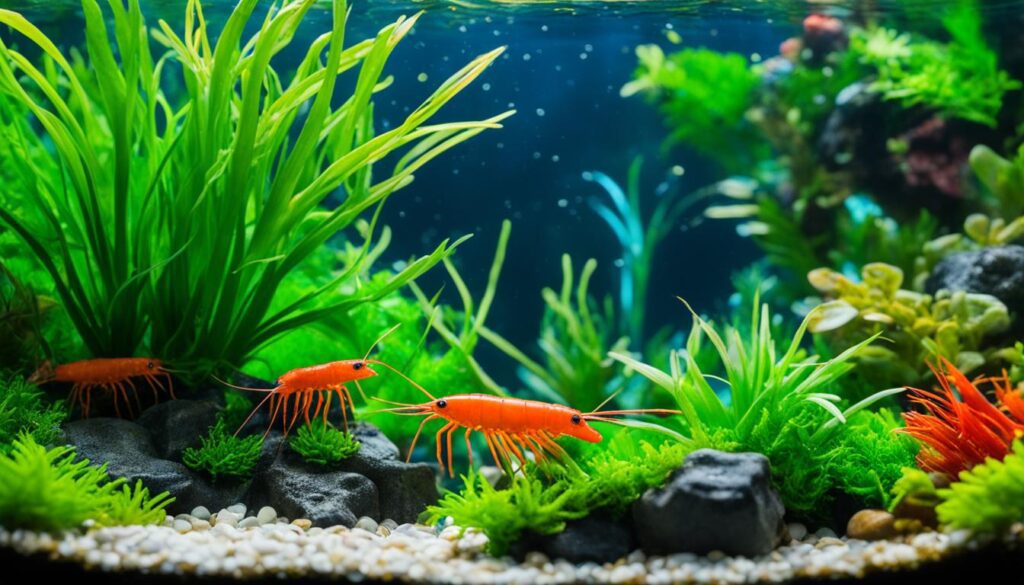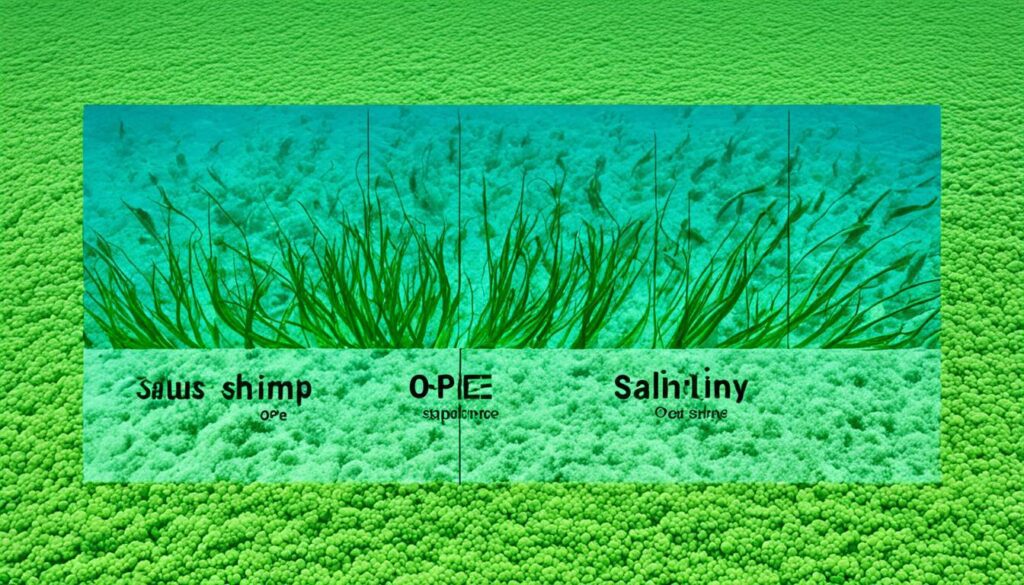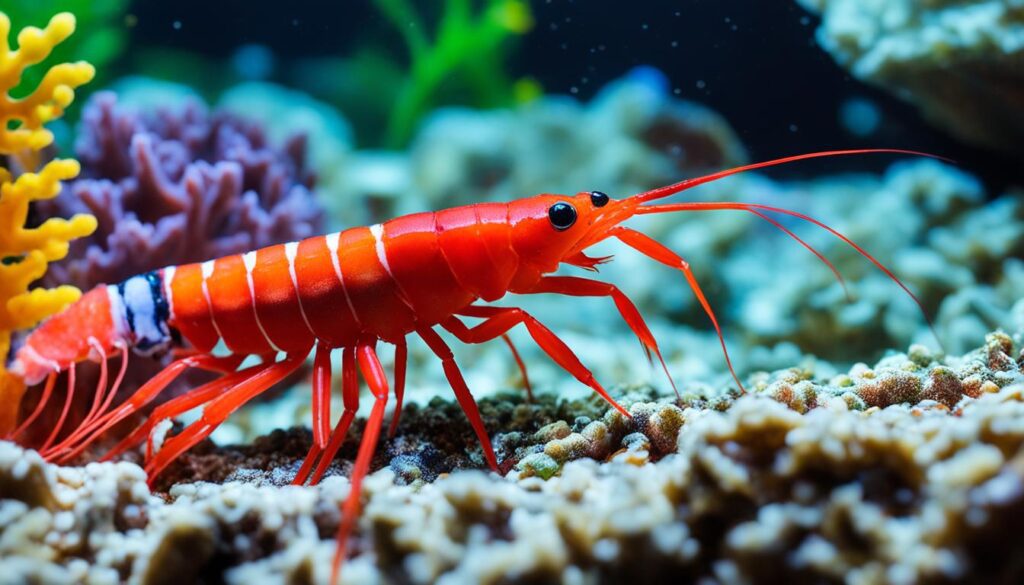Did you know that Opae Ula shrimp can live up to 20 years in a home aquarium? These tiny crustaceans, native to Hawaii’s islands like Maui and the Big Island, bring the charm of their natural anchialine pools right into your living room. My journey with these Hawaiian red shrimp has been nothing short of fascinating, filled with moments of discovery and learning.
To care for Opae Ula properly, it’s crucial to understand their needs. They’re not just pretty to look at—they’re incredibly resilient too. Taking care of them means replicating their unique environment, which involves setting up the right brackish water conditions and managing salinity levels. It’s a rewarding process that really lets you connect with these incredible little shrimp.
Unfortunately, urbanization is putting their natural habitats at risk. By setting up a habitat for Hawaiian red shrimp in our aquariums, we’re not just enjoying a piece of Hawaii—we’re helping to protect them, too. Every time I look at my tank, I feel a special connection to Hawaii and find peace in watching these shrimp swim around.
By following good care practices, we can bring a slice of Hawaiian nature into our homes. I’ve set up numerous tanks and learned a lot along the way—about patience, precision, and how to respect nature’s balance. These shrimp are a gentle reminder of how delicate and intricate nature can be.
We’ll dive into everything you need to know, from choosing the right tank size to picking the perfect substrate. Together, we’ll explore how to recreate an anchialine pool and keep your Opae Ula healthy and thriving for years to come. Let’s get started on this journey of caring for these amazing shrimp!
Opae Ula Shrimp Species Profile

The Opae Ula shrimp is a fascinating species from Hawaii. They live in special anchialine ecosystems along the coast. These places have both fresh and salt water, perfect for such species.
Conservation of Hawaiian shrimp is getting more attention. Their homes, anchialine pools, are beautiful but threatened.
An Introduction to Anchialine Shrimp
Anchialine pools are unique tidal water bodies. They are hidden in lava and limestone but have no direct sea surface link. The Opae Ula shrimp can handle different levels of salt in the water. This makes them interesting for scientific study and conservation.
Threats to Their Natural Habitats
The Opae Ula shrimp’s habitats face serious risks. Problems like urban growth, invasive species, and too much collecting for aquariums harm their homes. Protecting these habitats is key for those who care about the environment and research.
Differentiating Opae Ula from Other Shrimp Species
Opae Ula shrimp are known for their vivid red color and tiny size. Telling them apart from species like Neocaridina davidi is crucial. Knowing how they look helps protect them and focus conservation work.
We have a duty to protect and study the Opae Ula shrimp. It’s up to us to keep their special water homes safe and push for more research. Educating people and advocating for these creatures can preserve Hawaii’s unique eco-spots.
Setting Up the Perfect Brackish Aquarium

To make a perfect home for Opae Ula shrimp, you need to know key brackish aquarium essentials. These shrimp need a special setup for their habitats to be just right. Learn the steps to create a thriving brackish aquarium that follows Opae Ula tank guidelines.
Choosing the Right Tank Size
Size is crucial for the right habitat. Opae Ula shrimp do best in tanks that hold at least 2.5 gallons. This gives them enough room to act naturally and lets you add important things like substrate and decorations. Bigger tanks also keep the water conditions more stable, which is key for these shrimp.
Substrates and Decoration for Your Opae Ula Shrimp
For aquarium substrate selection, sand or fine gravel is the top choice. Skip crushed coral because it can mess with the water’s chemistry in bad ways. Shrimp-friendly decorations like rocks, driftwood, or fake caves don’t just look good. They also give shrimp places to hide, which makes them less stressed and copies their wild home.
Design your tank to look natural. It’s not just prettier, but it also helps your Opae Ula feel at home. The right setup, with the best hiding spots and substrate, really boosts your shrimp’s well-being.
Even if regular freshwater plants struggle in brackish water, some macroalgae types, like Chaetomorpha or Ulva, are great choices. These plants add color, help keep the water clean, and give your shrimp extra places to eat. They also help keep the oxygen levels up.
Getting your tank setup just right does wonders for your Opae Ula. It makes them thrive and turns your aquarium into a beautiful focal point. Paying close attention to these aspects ensures your brackish aquarium adventure is rewarding and enjoyable.
Maintaining Water Quality for Opae Ula Shrimp

Getting the brackish water preparation right is key for Opae Ula shrimp. These fascinating creatures need just the right Opae Ula salinity levels to thrive. Let’s dive into how to keep these levels perfect for them.
To start, it’s critical to pinpoint the exact salinity Opae Ula need. This range is usually between 1.008 and 1.018 specific gravity. Use a trustworthy refractometer to ensure the salinity stays in this essential range. For Opae Ula shrimp, consistent salinity is not just nice to have—it’s crucial for their life and health.
Besides salinity, the aquarium nitrogen cycle is critical for shrimp tank health. It’s vital to understand and manage this cycle to avoid deadly ammonia and nitrite spikes. By converting these toxins into safer nitrates, we can keep our shrimp safe. Here’s a breakdown of the cycle and water chemistry upkeep:
Nitrogen Cycle Stage |
Description |
Impact on Shrimp |
|---|---|---|
Ammonia Conversion |
Waste decomposes producing ammonia, highly toxic to shrimp. |
Can cause stress and death if not promptly converted. |
Nitrite to Nitrate |
Beneficial bacteria convert nitrites into nitrates, which are less toxic. |
Prevents nitrite poisoning, but nitrates should still be controlled. |
Water Changes |
Regular changes help control nitrate levels. |
Reduces risk of nitrate buildup, keeps shrimp healthy. |
The water’s quality is also key in your shrimp tank. I suggest using Reverse Osmosis (RO) water to avoid tap water contaminants like chlorine. If you’re in an area with very soft water, you may need to re-mineralize it. This step keeps water parameters stable for shrimp tank water chemistry.
To wrap up, balancing water chemistry and completing the aquarium nitrogen cycle are crucial for Opae Ula shrimp’s well-being. Always do regular checks and make necessary tweaks. Remember, in an aquarium, bad changes happen fast, good ones take time.
Feeding Your Opae Ula Shrimp

Feeding Opae Ula shrimp well is key to their health and long life. This species from Hawaii thrives in both nature and tanks. They need a special diet for good health and a balanced ecosystem.
Understanding Their Natural Diet
The natural shrimp diet is mainly algae, biofilm, and tiny organics. In nature, Opae Ula shrimp eat these all the time. This is essential for their nutrition and the environment. It is important to follow their natural feeding guidelines when keeping them in tanks.
Supplementing the Opae Ula’s Diet in Captivity
In captivity, mix in some prepared foods with their normal Opae Ula feeding habits. Although they need little food, adding quality shrimp food and treats helps prevent lack of nutrition. Use spirulina powder and algae wafers, but only give them a little to keep the water clean.
Set up a good aquarium feeding schedule. Only add food when needed and take out what they don’t eat. This careful feeding stops algae growth in shrimp tanks and keeps things balanced.
How to Prevent Overfeeding
Feeding Opae Ula shrimp too much can cause algae issues and bad water, hurting the shrimp. Feed them little and not too often. Watch the tank and change feeding as needed to avoid problems. A sign of good feeding is some algae and active shrimp.
Beginners should watch how shrimp react to new food. Change how much and how often you feed based on what you see. This keeps the shrimp healthy and stops too much algae.
Parameter |
Details |
|---|---|
Tank Size |
2.5 gallons |
Shrimp Quantity |
Approximately 20 |
Feed Type |
Algae wafers, Spirulina |
Feeding Frequency |
Once every 2-6 weeks, depending on algae availability |
Special Considerations |
Remove uneaten food after a few hours to prevent pollution |
Additional Recommendations |
Introduce nerite snails to help control algae |
Breeding Opae Ula Shrimp and Raising Their Larvae
I love keeping Opae Ula shrimp. The breeding process is fascinating yet detailed. Seeing my shrimp carry eggs to the care of their babies is a rewarding challenge. For the shrimp to carry eggs, the water and tank must be just right. They hold between 10 and 20 eggs for about five weeks if happy.
The larvae stage lasts 2-3 weeks. During this time, they take care of themselves without much help, showing how adaptable they are. With the right saltiness in my tank and keeping the water warm, I helped my shrimp babies grow. Keeping the water clean from ammonia and nitrate is also key to their growth.
Starting a tank and waiting for it to be ready takes patience. It takes around six months for the tank to settle. Then, breeding can start a few months after. I saw my first berried shrimp four months in. Opae Ula shrimp go from egg to adult in about two months. They have different needs at each life stage. I feed them spirulina powder once a week and keep the water warm to mimic their natural home. By being patient and paying attention to details, my shrimp colony grows strong. Adult shrimp can live up to 20 years, making this hobby deeply satisfying.








